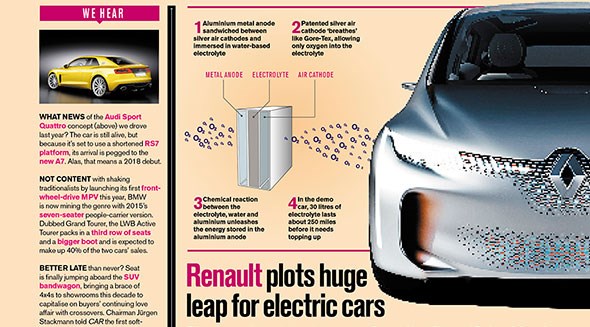► Renault battery tech explained
► Is aluminum-air the future for EVs?
► Our tech correspondent reports
Renault is the front-runner to adopt a game-changing aluminium-air battery, which could yield a sevenfold boost in the electric Zoe’s 130-mile range.
Aluminium-air (al-air) batteries have a phenomenal energy density, producing electricity when oxygen from the air oxidises aluminium. Approximately 4kWh of electricity and heat can be released from a single kilo of aluminium. Each al-air battery cell consists of a positive cathode and an aluminium negative anode, with water-based electrolyte in between.
Battery developer Phinergy’s breakthrough is a silver-based catalyst that only allows oxygen from the ambient air into the positive cathode. The O2 then combines with the liquid electrolyte, releasing the latent electrical energy stored within the aluminium anode. The genius is the ‘air cathode’, which acts like the breathable fabric Gore-Tex, letting in O2 but no carbon dioxide, which would foul the chemical reaction.
How aluminium-air batteries work
There are some major differences with a regular battery: they are closed cells, whereas the al-air battery uses an external element to trigger its chemical reaction. Also, once the al-air battery is switched off it remains dormant, with no power loss until turned on again. It’s like an on-board power station, that doesn’t need mains charging.
The reaction gradually consumes the aluminium though, so each cell’s anode has to be replaced depending on usage, like slotting a new cartridge into a printer. And you’ll have to stop every 250 miles to fill the ‘fuel’ tank with electrolyte. So al-air batteries will require electrolyte refuelling pumps at gas stations, though that’s simpler than the recharging points for today’s EVs.
The 600-mile-range electric car is near…
Phinergy’s Citroën C1 demonstrator uses 25kg of aluminium cells providing 100kWh, giving a 600-plus mile range (though with two 30-litre electrolyte top-ups). With its 50kW motor it has an 81mph top speed and 0-60mph in 14sec; Renault’s Zoe packs 22kWh, an 84mph v-max and 13.5sec to 62mph – but only a 130-mile range.
Lighter, more compact, with greater energy output and conceivably less than half the price of lithium-ion batteries, aluminium-air technology might just transform the EV’s appeal…
Let us know your reaction to this nascent technology in the comments below.
